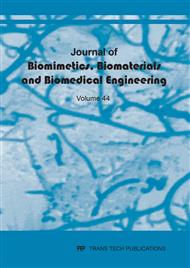[1]
Ansari, M., et al., An investigation on the effect of β-CD modified Fe3O4 magnetic nanoparticles on aggregation of amyloid b peptide (25-35). Materials Technology, 2016. 31(6): pp.315-321.
DOI: 10.1179/17535557b15y.000000002
Google Scholar
[2]
Omrani, M.M., et al., Enhanced bone marrow stem cell attachment and differentiation on PCL/CNT substrate. Inorganic and Nano-Metal Chemistry, 2019: pp.1-7.
DOI: 10.1080/24701556.2019.1586723
Google Scholar
[3]
Eslami, H., et al., Poly (lactic-co-glycolic acid)(PLGA)/TiO2 nanotube bioactive composite as a novel scaffold for bone tissue engineering: In vitro and in vivo studies. Biologicals, 2018. 53: pp.51-62.
DOI: 10.1016/j.biologicals.2018.02.004
Google Scholar
[4]
Oryan, A., et al., Bone regenerative medicine: classic options, novel strategies, and future directions. Journal of orthopaedic surgery and research, 2014. 9(1): p.18.
DOI: 10.1186/1749-799x-9-18
Google Scholar
[5]
Ansari, M., et al., Synthesis and characterisation of hydroxyapatite-calcium hydroxide for dental composites. Ceramics-Silikáty, 2011. 55(2): pp.123-126.
Google Scholar
[6]
Saberi, J., et al., Chitosan-Polyacrylic Acid Hybrid Nanoparticles as Novel Tissue Adhesive: Synthesis and Characterization. Fibers and Polymers, 2018. 19(12): pp.2458-2464.
DOI: 10.1007/s12221-018-8762-2
Google Scholar
[7]
Raucci, M.G., D. Giugliano, and L. Ambrosio, Fundamental properties of bioceramics and biocomposites. Handbook of Bioceramics and Biocomposites, 2016: pp.35-58.
DOI: 10.1007/978-3-319-12460-5_3
Google Scholar
[8]
Morteza, N.S., et al., Development and characterization of 316 L stainless steel coated by melt-derived and sol-gel derived 45s5 bioglass for orthopedic applications. Ceramics-Silikáty, 2012. 56(1): pp.89-93.
DOI: 10.1016/j.surfcoat.2010.11.048
Google Scholar
[9]
Rezwan, K., et al., Biodegradable and bioactive porous polymer/inorganic composite scaffolds for bone tissue engineering. Biomaterials, 2006. 27(18): pp.3413-3431.
DOI: 10.1016/j.biomaterials.2006.01.039
Google Scholar
[10]
Wu, C., et al., Porous akermanite scaffolds for bone tissue engineering: preparation, characterization, and in vitro studies. Journal of Biomedical Materials Research Part B: Applied Biomaterials: An Official Journal of The Society for Biomaterials, The Japanese Society for Biomaterials, and The Australian Society for Biomaterials and the Korean Society for Biomaterials, 2006. 78(1): pp.47-55.
DOI: 10.1002/jbm.b.30456
Google Scholar
[11]
Wu, C. and J. Chang, Synthesis and apatite-formation ability of akermanite. Materials Letters, 2004. 58(19): pp.2415-2417.
DOI: 10.1016/j.matlet.2004.02.039
Google Scholar
[12]
Gao, C., et al., Carbon nanotube, graphene and boron nitride nanotube reinforced bioactive ceramics for bone repair. Acta biomaterialia, 2017. 61: pp.1-20.
DOI: 10.1016/j.actbio.2017.05.020
Google Scholar
[13]
Wu, C. and J. Chang, Degradation, bioactivity, and cytocompatibility of diopside, akermanite, and bredigite ceramics. Journal of Biomedical Materials Research Part B: Applied Biomaterials: An Official Journal of The Society for Biomaterials, The Japanese Society for Biomaterials, and The Australian Society for Biomaterials and the Korean Society for Biomaterials, 2007. 83(1): pp.153-160.
DOI: 10.1002/jbm.b.30779
Google Scholar
[14]
Wu, C., et al., A novel bioactive porous bredigite (Ca 7 MgSi 4 O 16) scaffold with biomimetic apatite layer for bone tissue engineering. Journal of Materials Science: Materials in Medicine, 2007. 18(5): pp.857-864.
DOI: 10.1007/s10856-006-0083-0
Google Scholar
[15]
Ni, S., J. Chang, and L. Chou, A novel bioactive porous CaSiO3 scaffold for bone tissue engineering. Journal of Biomedical Materials Research Part A: An Official Journal of The Society for Biomaterials, The Japanese Society for Biomaterials, and The Australian Society for Biomaterials and the Korean Society for Biomaterials, 2006. 76(1): pp.196-205.
DOI: 10.1002/jbm.a.30525
Google Scholar
[16]
Mihailova, I., et al., Novel merwinite/akermanite ceramics: in vitro bioactivity. Bulgarian Chemical Communications, 2015. 47: p.253.
Google Scholar
[17]
Federman, S.R., et al., Sol-Gel SiO2-CaO-P2O5 biofilm with surface engineered for medical application. Materials Research, 2007. 10(2): pp.177-181.
DOI: 10.1590/s1516-14392007000200014
Google Scholar


